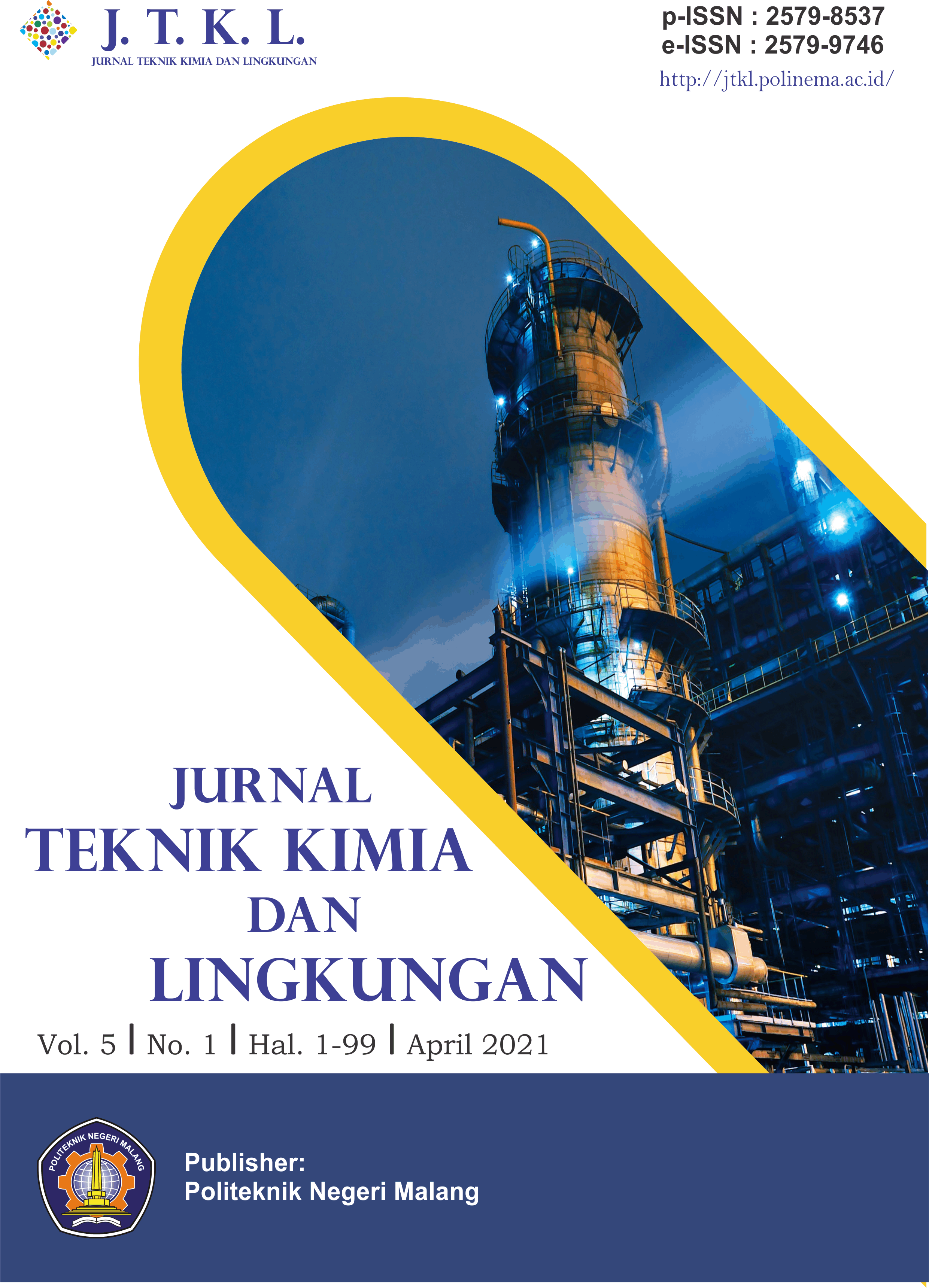Pengaruh Jenis Komposter dan Waktu Pengomposan terhadap Pembuatan Pupuk Kompos dari Activated Sludge Limbah Industri Bioetanol
DOI:
https://doi.org/10.33795/jtkl.v5i1.209Keywords:
activated sludge, aeration, bioactivator, composter, non-aeration.Abstract
Side product of the waste water treatment plant in the bioethanol industry produces solid waste in the form of activated sludge.This waste can cause problems if not handled properly. Among them are reducing the nutrient content in the soil and polluting clean water sources when they enter river bodies. Activated sludge waste from the anaerobic biodigester process in the bioethanol industry can be used as organic fertilizer by composting. The purpose of this study was to determine the effect of composter design and composting time in making compost from activated sludge of bioethanol industrial waste on the content of compost produced. In composting process used an EM4 as bioactivator. The composter design used is an aerated composter and a non-aerated composter. The composting time used is blank, week 1, week 2, week 3 and week 4. From the analysis, it was found that the physical characteristics of compost were temperature, pH, humidity, C organic, total N, total P, total K, and the
C / N ratio according to SNI 19-7030-2004. The use of aerated and non aerated design composters produces quality compost that meets SNI 19-7030-2004. The longer composting time will provide better quality compost.
References
S. Dutta, P. William, B.K., Sarangi, S. Lokhande, V.M. Shinde, H.J. Purohit, A.N. Vaidya, Response of anaerobic digester sludge for activator aided rapid composting and its effects oncompost quality, Int. J. Waste Resour., vol. 6, no. 2, hal.1-6, 2016.
E. Supriyatni, M. Yazid, E. Nuraini, Sunardi, Aplikasi pengaktif neutroncepat untuk penentuan kandungan unsur N, P dan K di dalam sludge, in: Pertemuan Ilmiah Teknologi dan Aplikasi Akselerator, BATAN Yogyakarta Indonesia, Okt. 2003.
I. Ekawati, Pengaruh pemberian inokulum terhadap kecepatan pengomposan jerami padi, Tropica J. Penelitian, vol. 11, no. 2, hal. 144-152, 2003.
S.N. Afid, E. Harlia, W. Juanda, Potensi sludge biogas feses sapi perah sebagai sumber bakteri anaerob penghasil gas metana, Jurnal Universitas Padjadjaran, vol.5, no.3, 2016.
R. Sutanto, Pertanian Organik: Menuju Pertanian Alternatif dan Berkelanjutan, Kanisius: Yogyakarta, 2002.
I. Isroi, Kompos, in: Study Research Siswa SMU Negeri 81 Jakarta, Bogor di Balai Penelitian Bioteknologi Perkebunan Indonesia Bogor Indonesia, Feb. 2008.
A. Ismaya., N. S. Indrasti, A. Madu, Faktor rasio C/N awal dan laju aerasi pada proses co-composting bagasse dan blotong, J. Tek. Ind. Pert., vol. 22 no. 3, hal. 173-179, 2012.
H. Manurung, Aplikasi bioaktivator (effective microorganisme dan orgadec) untuk mempercepat pembentukan kompos limbah kulit pisang kepok (Musa paradisiacal L.), Bioprospek, vol. 8, no. 2, hal. 1-14, 2011.
I. Mahadi, D. Darmawati, S. Rachmadani, Pengujian terhadap jenis bioaktivator pada pembuatan kompos limbah pertanian, J. Din. Pertan., vol. XXIX, no. 3, hal. 237–244, 2014.
U. Ubaidillah, M. Maryadi, R. Dianita, Karakteristik fisik dan kimia phospho-kompos yang diperkaya dengan abu serbuk gergaji sebagai sumber kalium, Jurnal Ilmiah Ilmu-ilmu Peternakan, vol. 21, no. 2, hal. 98–109, 2018.
P. Widiyaningrum, L. Lisdiana, Efektivitas proses pengomposan sampah daun dengan tiga sumber aktivator berbeda, Rekayasa, vol. 13, no. 2, hal. 107–113, 2015.
M. Bozym, G. Siemiatkowski, Characterization of composted sewage sludge during the maturation process : a pilot scale study, Environ. Sci. Pollut. Res. Int., vol. 25, no. 34, hal. 34332–34342, 2018.
A. A. N. Supadma, D. M. Arthagama, Uji formulasi kualitas pupuk kompos yang bersumber dari sampah organik dengan penambahan limbah ternak ayam, sapi, babi, dan tanaman pahitan, Jurnal Bumi Lestari, vol 8, no. 2, hal 113-121, 2018.
T. C. Kurniawan, R. Noor, Pemanfaatan limbah lumpur Pd Pal sebagai bahan pembuatan pupuk organik, Infoteknik, vol. 15, no. 1, hal. 87-102, 2014.
S. M. Hastuti, G. Samudro, S.Sumiyati, Pengaruh kadar air terhadap hasil pengomposan sampah organik dengan metode composter tub, J. Tek. Mesin, vol 6, no. 2, hal. 114-118, 2017.
A. A. Hidayati, D. N. Winardi, S. Syafrudin, Pengomposan Sludge hasil pengolahan limbah cair PT . Indofood CBP dengan penambahan lumpur aktif dan EM4 dengan variasi sampah domestik dan bawang goreng, J. Tek. Ling., vol. 2, no. 3, hal. 1–8, 2013.
S. A. K. Tweib, A. I. Ekhmaj, Co-Composting of sewage sludge with food waste using bin composter, Al-Mukhtar Journal Science, vol. 33, no. 1, hal. 24-35 2017.
D. Jovita, Analisis unsur makro (K, Ca, Mg) mikro (Fe, Zn, Cu) pada lahan pertanian dengan metode inductively coupled plasma optimal emission spectrofotometry, Undergraduate Thesis, Fak. Matematika dan Ilmu Pengetahuan Alam, Univ. Lampung, Lampung, 2018.
Downloads
Published
Issue
Section
License
Copyright (c) 2023 Wianthi Septia Witasari, Khalimatus Sa'diyah, Mohammad Hidayatulloh

This work is licensed under a Creative Commons Attribution-NonCommercial 4.0 International License.







